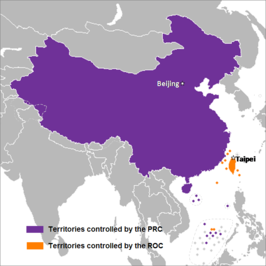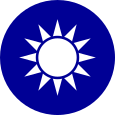
Back سياسة الصينيتان Arabic Два Китая Bulgarian Dos Chinas Spanish Deux Chines French Lióng ke Chûng-koet HAK Dua Tiongkok ID 二つの中国 Japanese 두 개의 중국 Korean Controversiae duarum civitatum Sinicarum Latin Dua China Malay
This article needs additional citations for verification. (February 2021) |
| Two Chinas | |||||||||||||
|---|---|---|---|---|---|---|---|---|---|---|---|---|---|
 Territories controlled by the People's Republic of China (PRC) (purple) and the Republic of China (ROC) (orange). The size of minor islands controlled by the PRC, the ROC, and other countries (gray) has been exaggerated in this map for ease of identification. | |||||||||||||
| Traditional Chinese | 兩個中國 | ||||||||||||
| Simplified Chinese | 两个中国 | ||||||||||||
| |||||||||||||
 |
|---|
|
|
 |
|---|
|
|
The concept of Two Chinas refers to the political divide between the People's Republic of China (PRC) and the Republic of China (ROC). The PRC was established in 1949 by the Chinese Communist Party, while the ROC was founded in 1912 and retreated to Taiwan after losing the Chinese Civil War.
Despite both claiming to be the legitimate government of all of China (One China), they operate as separate entities with different political systems and ideologies. The differences between the two Chinas are stark, with the PRC being a one-party communist state and the ROC a multi-party democracy after transitioning from one-party military rule. Both countries maintain separate diplomatic relations.[1][2]
- ^ Gayner, Jeffrey B (2 July 1977). "U.S. Diplomacy and the Two Chinas". Archived from the original on 18 January 2021. Retrieved 19 March 2021.
- ^ Swift, John (2003). "The Two Chinas". The Palgrave Concise Historical Atlas of the Cold War. pp. 44–45. doi:10.1057/9780230001183_20. ISBN 978-0-333-99404-7. Archived from the original on 2023-04-11. Retrieved 2021-02-11.
